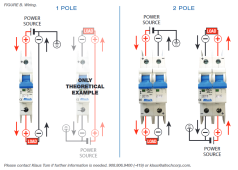Circuit breaker arc flash fires are caused by poor arc chute design or incorrect current flow in the breakerView attachment 75101
I looked up those DC breakers,
My guess is that there is some sort of "Diode" mechanism inside, which doesn't like being run the other way around.
Don't know how they work mechanical but the symbols are different from AC:
View attachment 75102
Also by using an AC rated breaker on a DC circuit
Some (old standard) DC breakers are polarity sensitive, there is only one acceptable current flow direction
Current certification is non-polarity sensitive.
There is no diode in a circuit breaker, current flow direction has to do with the arc chute (arc extinguishing mechanism)
Old stock CBI (Circuit Breaker International) breakers are polarity sensitive
codes have changed
Current stock CBI breakers are not polarity sensitive
Carlingswitch breakers are not polarity sensetive......MidNite MNDC breakers are manufactured and labeled by Carlingswitch
Beware, many imported circuit breakers are polarity sensitive
AC breakers do not have an “arc chute” and have no way to extinguish an DC arc.
Very few breakers are rated for AC or DC
Carlingswitch “C” “D” and “E” series breakers are rated for both AC and DC
Schneider Electric Square D QO line breakers are rated 150 VAC and 48 VDC
Last edited:






